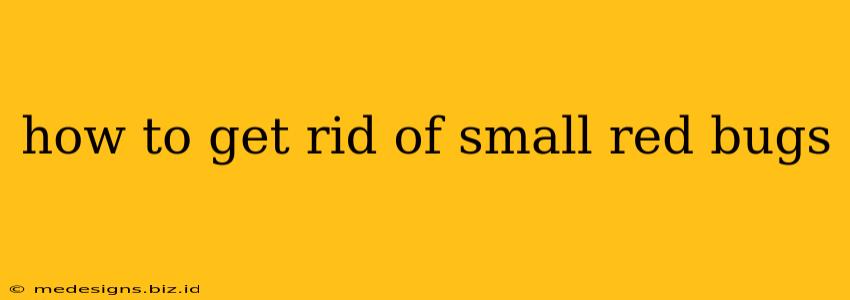Are you battling an infestation of tiny red bugs in your home or garden? These pesky critters can be incredibly frustrating, causing itchy bites, damaging plants, and generally making life unpleasant. This comprehensive guide will help you identify the culprit and effectively eliminate them, restoring peace to your space.
Identifying Your Tiny Red Invaders
Before you start spraying anything, it's crucial to identify the type of small red bug you're dealing with. Different bugs require different treatment methods. Common culprits include:
- Spider Mites: These minuscule pests are barely visible to the naked eye and infest plants, causing stippling and webbing. They're often found on houseplants.
- Chiggers: These larval mites are notorious for their itchy bites. They're commonly found in grassy areas and wooded regions.
- Red Velvet Mites: These harmless mites are often found in large numbers, particularly during the fall. While alarming in appearance, they don't bite or cause damage.
- Bed Bugs: Although not always red, young bed bugs can appear reddish-brown and are a significant pest, known for their bites and infestation of mattresses and bedding.
- Other Insects: Many other small insects can appear red, including certain species of ants, beetles, and aphids.
Take a close look at the bugs! Note their size, shape, behavior (do they bite?, where are they found?, etc.), and any noticeable patterns. If you're unsure, taking a clear picture and searching online or consulting a pest control professional can help with identification.
Effective Methods to Eliminate Small Red Bugs
Once you've identified the type of bug, you can choose the appropriate method for elimination. Here are some effective approaches:
For Plants Infested with Spider Mites or Other Pests:
- Neem Oil: This natural insecticide is effective against many plant pests, including spider mites. Apply according to the product instructions.
- Insecticidal Soap: Another natural option, insecticidal soap disrupts the cell membranes of insects, leading to their death. Thoroughly coat the affected plants.
- Water Spray: For light infestations, a strong spray of water can dislodge spider mites from plants.
- Beneficial Insects: Introducing predatory insects like ladybugs or lacewings can help control mite populations naturally.
For Chiggers:
- Repellents: Use insect repellents containing DEET or picaridin when spending time outdoors in areas where chiggers are prevalent.
- Clothing Protection: Wear long sleeves, long pants, and socks to minimize skin exposure.
- Showering After Exposure: Showering immediately after potential exposure to chiggers can help remove any attached larvae.
- Treat Bites: Use calamine lotion or hydrocortisone cream to soothe itchy bites.
For Bed Bugs:
- Professional Pest Control: Bed bug infestations are notoriously difficult to eliminate. It's essential to contact a professional pest control service for effective treatment. They have specialized tools and treatments for thorough eradication.
- Encasements: Protect your mattress and box spring with encasements that prevent bed bugs from accessing them.
- Thorough Cleaning: Wash and dry all bedding and clothing on high heat.
General Tips for Pest Control:
- Maintain Cleanliness: Regularly clean and vacuum your home, paying close attention to areas where bugs might congregate.
- Identify Entry Points: Seal any cracks or gaps in walls or windows that might allow bugs to enter.
- Reduce Moisture: High humidity can attract some pests. Ensure proper ventilation in your home.
Remember: If you're struggling to identify the bugs or control the infestation, consulting a pest control professional is always the best course of action. They can provide accurate identification and effective treatment strategies tailored to your specific situation. Early intervention is key to preventing a larger infestation.
